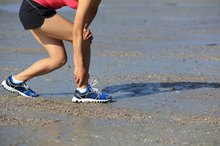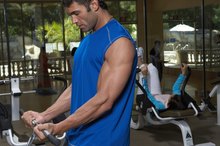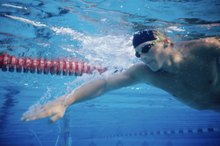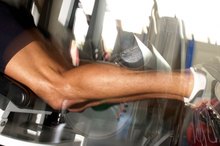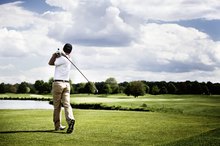Left Arm Muscle Pain With a Golf Swing
Occasional muscle pain is a common side effect of performing any athletic activity, including playing golf. Right-handed golfers in particular rely on the muscles in their left arms and left side of their torso to provide force needed for a good golf swing. Muscle pain in your left arm with a golf swing might occur for a number of reasons, ranging from temporary discomfort to a serious injury.
Delayed-Onset Muscle Soreness
One possible cause of left arm pain during a golf swing is delayed-onset muscle soreness, or DOMS. This soreness occurs when you exert one or more of the muscles in your left arm. For example, if you resume playing golf for the first time in awhile, or play a longer round of golf than you’re used to, then you might experience soreness during a golf swing if you play golf again the next day. The soreness develops due to microscopic tears that occur in your muscle tissue as a result of exercise. These tears ultimately prove beneficial for strengthening your muscles, but can cause temporary pain that lasts for 24 to 48 hours after exercise.
- One possible cause of left arm pain during a golf swing is delayed-onset muscle soreness, or DOMS.
- These tears ultimately prove beneficial for strengthening your muscles, but can cause temporary pain that lasts for 24 to 48 hours after exercise.
Muscle Injuries
Causes of Upper Arm Muscle Pain
Learn More
If you’re suffering from very severe or sharp pains in your left arm during a golf swing, you might have suffered a muscle injury. During athletic activities, your muscles might become strained, or fibers within your muscles might tear an abnormal amount, beyond the normal microscopic tears that cause DOMS.
Dealing with DOMS and Muscle Injuries
You can help tell the difference between DOMS and injuries through differences in the type of muscle pain. DOMS often causes discomfort whenever you contract the sore muscles, and might present a dull ache at all times. Muscle injuries might cause a sharp stabbing pain when you perform one specific movement, might throb throughout the day, or might prove painful enough to interfere with your daily functioning. DOMS should subside after a few days of rest, during which time you should not play more golf. Muscle injuries require medical attention, and might not heal on their own.
- You can help tell the difference between DOMS and injuries through differences in the type of muscle pain.
- DOMS often causes discomfort whenever you contract the sore muscles, and might present a dull ache at all times.
Considerations
Causes of Calf Pain During Jumping Jacks
Learn More
In addition to muscle injuries, pain in your left arm after playing golf might indicate another type of injury. Golfers might develop tendonitis in the left hand, for example, as a result of poor form when golfing, according to a study published in “Physical Medicine and Rehabilitation Clinics of North America” in 2006 2. You might also develop a torn rotator cuff in your shoulder, or even, in some cases, a stress fracture of your bone. These injuries all require medical attention, and respond to different treatments. If you experience severe or prolonged pain after playing golf, consult a doctor to receive appropriate treatment.
- In addition to muscle injuries, pain in your left arm after playing golf might indicate another type of injury.
- Golfers might develop tendonitis in the left hand, for example, as a result of poor form when golfing, according to a study published in “Physical Medicine and Rehabilitation Clinics of North America” in 2006 2.
Related Articles
References
- Washington University at St. Louis: Muscle Pain
- Physical Medicine and Rehabilitation Clinics of North America: Golf Injuries and Rehabilitation
- Hospital for Special Surgery: Golf Injury Prevention Tips
- Mayo Clinic Staff. Golf Stretches. The Mayo Clinic. 2018
- Leslie E. Smith et al. Acute and Chronic Health Benefits of TRX® Suspension Training®. American Council on Exercise sponsored study. 2016
- Mayo Clinic Staff. Golf Stretches. The Mayo Clinic. 2018
- TRX Training. TRX For Golf: TRX Golf Swing (Opposite Hands). 2016
Writer Bio
Sylvie Tremblay holds a Master of Science in molecular and cellular biology and has years of experience as a cancer researcher and neuroscientist. Based in Ontario, Canada, Tremblay is an experienced journalist and blogger specializing in nutrition, fitness, lifestyle, health and biotechnology, as well as real estate, agriculture and clean tech.
